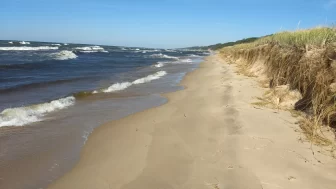
Image: Wikimedia
By A.J. Evans
There have been more than 300 reported drownings in the Great Lakes region over the last three years, according to the non-profit Great Lakes Surf Rescue Project. Last year’s total of 108 drownings matched the amount for 2020. So far this year, there have been 30 reported drownings, with Lake Michigan accounting for almost half of those, with 11.
Dave Benjamin is the co-founder and executive director of the Great Lakes Surf Rescue Project. He says several factors contribute to this issue, including Michigan discontinuing its lifeguard program for state park beaches.
“Unfortunately, the state of Michigan terminated its program for lifeguards in the ‘90s, and unfortunately they’ve been kinda winging it ever since,” said Benjamin. “It’s unacceptable that state park beaches and national park beaches do not have lifeguards. Because essentially you’re saying, ‘Bring your tourist dollars to our beaches and our beach communities, and if you get in trouble in the water you’re on your own.’ ”
Since 2019, there have been 444 recorded drownings in the Great Lakes, and almost half of them occurred in Lake Michigan, with 208 recorded drownings since then.
“On average, almost half of all Great Lakes drownings each year will happen on Lake Michigan,” said Benjamin. “Lake Michigan has a high population density, it’s a high tourist destination, and we have a vast amount of beaches that are unguarded.”
Benjamin says currents and unpredictable winds on densely populated beaches around Lake Michigan contribute to drownings each year. He also warned of the dangers of offshore wind currents.
“If there’s an offshore wind current, the wind is blowing from the land out to open water, and anything that floats can go far and fast offshore,” said Benjamin. “So kids on inner tubes, or inflatable ducks can go far and fast offshore in the offshore wind. Or even footballs and volleyballs. Kids have a tendency to try and chase after them to try and catch them, and then they get in water over their head and they get in trouble.”
This year, the Michigan Department of Natural Resources enacted a new double-flag warning system on swimming beaches around the Great Lakes. The double red flags close access to the water and prohibit beach visitors from entering the water. The flags are an addition to the Great Lakes flag warning system, where a green, yellow, and single-red flag communicate the safety of the current water conditions for swimmers and visitors at state park beaches.
However, without lifeguards, Benjamin mentioned that the flags often don’t get updated in a timely manner, leaving visitors to decide for themselves whether they should enter the water.
“Beach flags are a tool for lifeguards to use, to educate and warn the public about the surf conditions,” said Benjamin. “What happened is, they terminated the lifeguards, and kept the flags. So they don’t update the flags in real time.”
Benjamin said there can also be discrepancies within the system, depending on the park and beach. “There will be times when Warren Dunes State Park will have a yellow flag flying. It will say waves zero feet, water temperature 46 degrees. The same exact conditions in Holland, Michigan, will say waves zero feet, water temperature 46 degrees, dangerously cold, with a green flag flying.”
Pat Whalen is the Plainwell district supervisor for the Michigan Department of Natural Resources. He acknowledged the criticisms of the flag system.
“There’s some criticism from some groups as far as when we post them, the colors we post, the wave height, but again we want to remind people that those observations for the lake are being taken in real time,” said Whalen. “We base that off their judgment and the on-site conditions, not off a camera that may be further away from the beach location or from an offshore buoy that may be measuring wave heights that are much different than what is occurring onshore,” Whalen said.
Whalen also noted that the flag system is only designated for state park beaches with staff members available to monitor the water.
“The flag systems are only on our designated park beaches. Those are at beaches and parks where we have staff available,” said Whalen. “We have commissioned park officers and park rangers that would be monitoring lake conditions. They start first thing in the morning normally around 8-8:30, they’ll go out and look at the lake conditions, determine the wave pipe, and take the water temperature, and determine the flag color from there.”
Whalen says Warren Dunes and Holland are two of the more popular parks in the Plainwell District, and staff members are there to monitor the water all day.
“So they can monitor that very closely and make those changes as needed. Some of the other units may not have staff right on the beach. They would check those on a regular basis to see if those wave conditions merit a change in the flag color,” Whalen said.
The Great Lakes Surf Rescue Project’s Dave Benjamin said at some city beaches, such as South Haven, lifeguards are present. However, he said state park beaches across Michigan remain devoid of lifeguards to correct the flag system, and address a growing problem within the Great Lakes and across the state of Michigan.
A.J. Evans has an environmental reporting internship under the MSU Knight Center for Environmental Journalism’s diversity reporting partnership with the Mott News Collaborative. This story was produced for Michigan Radio.